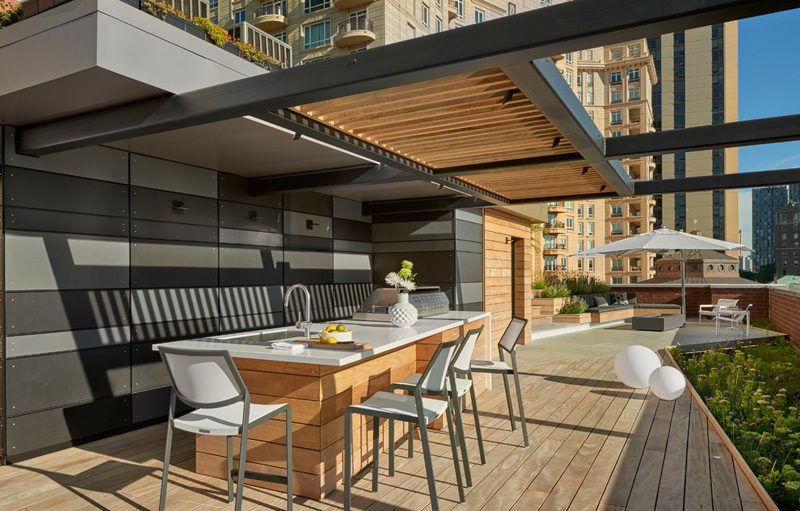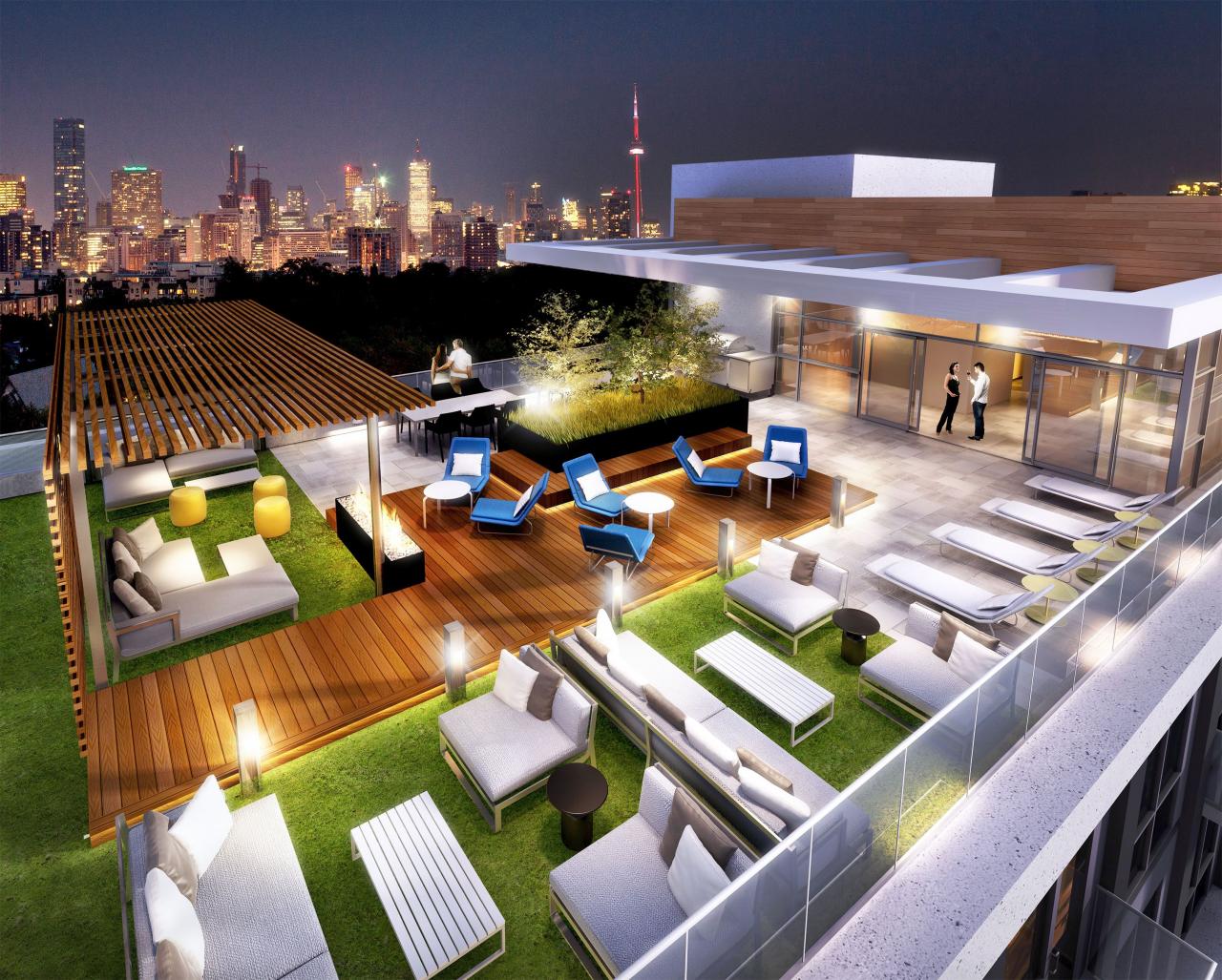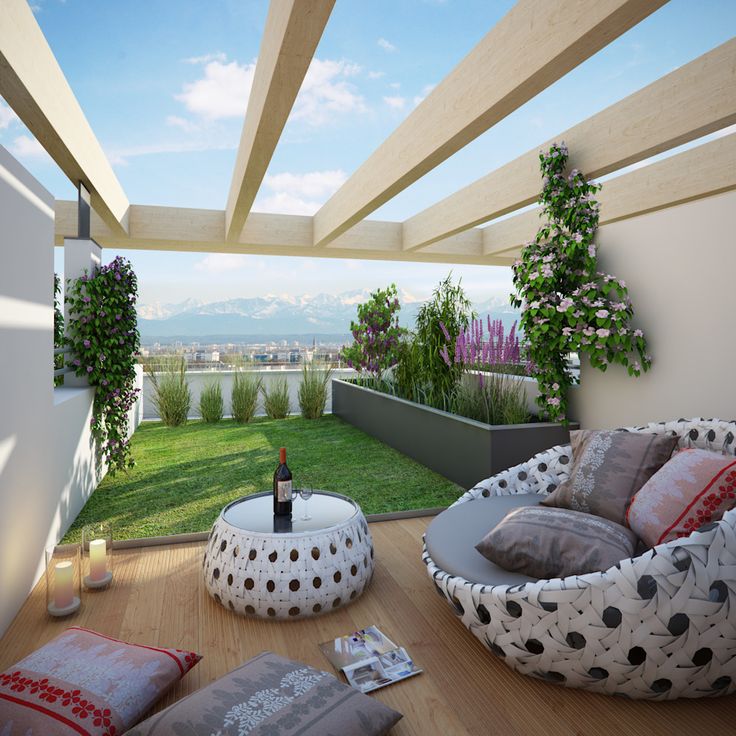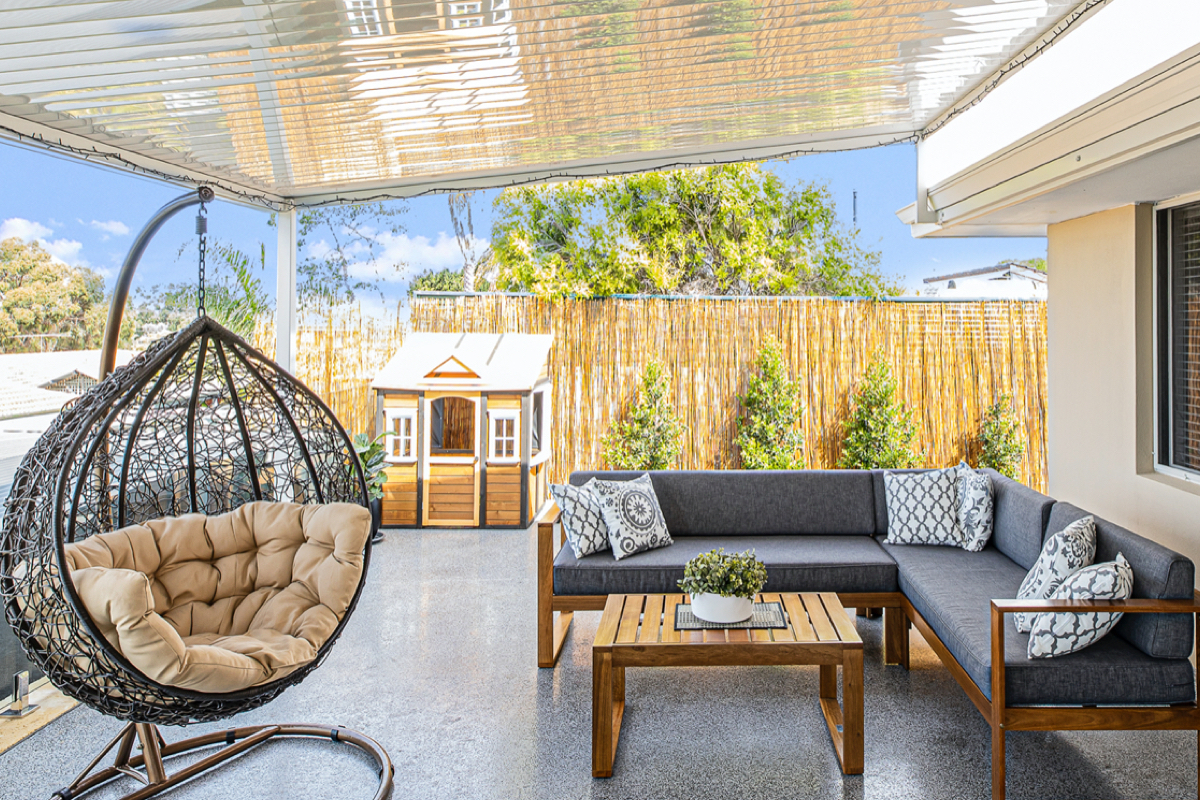Creating a functional and stylish rooftop patio design for entertaining isn’t just about adding square footage; it’s about crafting an outdoor oasis where memories are made. Imagine: balmy evenings, laughter echoing under the stars, and the perfect blend of comfort and chic. This guide dives deep into transforming your rooftop into the ultimate entertainment hub, from selecting the right materials to curating the ideal ambiance.
Get ready to turn your rooftop dreams into a reality!
We’ll explore everything from designing a layout that seamlessly integrates seating and dining areas to choosing durable, weather-resistant materials. Learn how to incorporate stylish furniture, captivating lighting, and lush greenery to create a space that’s both functional and visually stunning. We’ll even cover the fun stuff – like adding a built-in grill or outdoor sound system to elevate your entertaining game.
Prepare to be inspired!
Defining the Scope and Style of the Rooftop Patio

Transforming a rooftop into a functional and stylish entertainment space requires careful planning and a clear vision. This involves defining the scope of the project, considering the building’s architecture and surroundings, and selecting a design style that complements both the building and your personal preferences. The ultimate goal is a space that seamlessly blends aesthetics with practicality, creating an inviting and memorable experience for guests.Designing a rooftop patio for entertaining necessitates a thoughtful layout that balances functionality with style.
It’s crucial to determine the desired capacity and the types of events you plan to host. This will inform decisions about seating arrangements, dining areas, and the overall flow of the space. The inclusion of both comfortable seating areas for relaxed conversation and a designated dining area for meals is essential for versatile entertaining.
Rooftop Patio Layouts for Entertaining
A well-designed rooftop patio layout prioritizes efficient use of space and a smooth flow for guests. For example, a larger patio might incorporate separate zones for lounging, dining, and a bar area. Smaller spaces can benefit from multi-functional furniture, such as ottomans that double as seating and coffee tables, maximizing space without compromising comfort. Consider traffic flow; ensure there’s ample space for movement between seating and dining areas, and easy access to the entry and exit points.
The placement of lighting and landscaping elements also plays a vital role in shaping the ambiance and functionality of the space.
Stylish Rooftop Patio Designs by Architectural Style
The architectural style of the building and its surroundings significantly influence the design of the rooftop patio. A modern building might call for a sleek, minimalist patio with clean lines and contemporary furniture. Imagine a space featuring a low-slung concrete sectional sofa, geometric planters with drought-tolerant succulents, and minimalist pendant lighting. In contrast, a rustic building might be complemented by a patio with natural materials like wood and stone, comfortable wicker furniture, and string lighting creating a warm, inviting atmosphere.
A Mediterranean-style building could inspire a patio with whitewashed walls, terracotta tiles, wrought-iron furniture, and lush greenery, evoking a sense of relaxed elegance.
The Importance of Architectural Harmony and Context
Integrating the rooftop patio seamlessly with the building’s architecture and its surroundings is paramount. A patio that clashes with the building’s style will look out of place and detract from the overall aesthetic. For instance, a traditional Victorian building would look jarring with a stark, modern patio. Similarly, the surrounding environment should be considered; a rooftop patio overlooking a bustling city might benefit from a more enclosed and private design, while a patio with a view of a serene landscape could embrace an open and airy layout.
The aim is to create a harmonious blend of the patio design and its context.
Rooftop Patio Mood Board: Design Elements, Creating a functional and stylish rooftop patio design for entertaining
A successful rooftop patio design is a careful orchestration of various design elements. Imagine a mood board showcasing the following:* Furniture: A mix of comfortable seating options, including a modular sofa in a neutral tone, plush armchairs in a complementary color, and perhaps a stylish daybed for lounging.
Lighting
Warm, ambient lighting is key. This could include string lights draped across the patio, strategically placed pathway lighting, and stylish pendant lights above the dining area. Consider incorporating solar-powered options for sustainability.
Landscaping
Low-maintenance plants in large, modern planters would add a touch of greenery without overwhelming the space. Consider drought-tolerant succulents or herbs, depending on the climate. A small water feature, such as a tabletop fountain, could add a soothing element.
Accessories
Outdoor rugs, throw pillows, and blankets in coordinating colors and textures add warmth and personality.
Materials and Construction Considerations
Transforming your rooftop into a stylish and functional entertainment space requires careful consideration of materials and construction. The choices you make will significantly impact the longevity, safety, and overall aesthetic of your patio. Selecting durable, weather-resistant materials is crucial for withstanding the elements and ensuring your investment lasts.
Rooftop Patio Flooring Materials
Choosing the right flooring is paramount for both comfort and durability. Several options exist, each with its own set of advantages and disadvantages. Wood, while aesthetically pleasing, requires regular maintenance and is susceptible to rot and warping in harsh weather. Tile offers excellent durability and weather resistance, but can be cold underfoot and prone to cracking under heavy loads. Composite decking strikes a balance, offering the look of wood with enhanced durability and weather resistance, often requiring less maintenance than natural wood.
Designing a functional and stylish rooftop patio for entertaining requires careful planning. Consider the flow, incorporating comfortable seating and a chic bar area; for upscale menu inspiration, check out the rh rooftop menu charlotte , which offers amazing ideas for your guests. Then, tailor your design to reflect your personal style, ensuring both functionality and aesthetic appeal for memorable gatherings.
The best choice depends on your budget, aesthetic preferences, and the specific climate conditions of your location. For instance, in a region with heavy snowfall, a durable tile might be preferable to wood, which could be damaged by repeated freeze-thaw cycles.
Structural Requirements for Rooftop Patios
Building a safe and stable rooftop patio necessitates careful attention to structural integrity. The existing roof structure must be capable of supporting the added weight of the patio, furniture, and occupants. A structural engineer should assess the roof’s load-bearing capacity before any construction begins. This assessment will determine the allowable weight limits and inform the design of the patio structure.
Waterproofing is equally critical. A robust waterproofing system, including proper drainage and flashing, is essential to prevent leaks and protect the building’s structure. Neglecting waterproofing can lead to costly repairs and structural damage. For example, a poorly sealed patio could lead to water seeping into the building, causing mold growth and damage to interior finishes.
Designing a functional and stylish rooftop patio for entertaining requires careful planning. Consider the flow of traffic, incorporating comfortable seating, and of course, delicious food – perhaps drawing inspiration from the sophisticated menu offerings at the rh marin rooftop menu , which showcases creative culinary pairings. Ultimately, your rooftop oasis should reflect your personal style while providing a seamless and enjoyable experience for your guests.
Railing Systems for Safety and Aesthetics
Safety is paramount on a rooftop patio. A sturdy and appropriately designed railing system is crucial for preventing falls. Various materials can be used, each with its own pros and cons.
| Material | Pros | Cons | Cost |
|---|---|---|---|
| Wood | Aesthetically pleasing, relatively easy to install | Requires regular maintenance, susceptible to rot and decay, can be less durable than metal | Moderate |
| Metal (Aluminum, Steel) | Durable, weather-resistant, low maintenance | Can be more expensive than wood, may require specialized tools for installation, can get hot in direct sunlight (steel) | High (Steel), Moderate (Aluminum) |
| Glass | Modern aesthetic, provides excellent views | Can be expensive, requires careful handling and installation, may require more frequent cleaning | High |
| Composite | Low maintenance, durable, weather-resistant, variety of styles | Can be more expensive than wood, may fade over time | High |
The height and spacing of the railing must comply with local building codes. The aesthetic appeal of the railing should also be considered, ensuring it complements the overall design of the patio and the building. For example, a sleek, modern metal railing might be suitable for a contemporary rooftop design, while a more traditional wood railing might be a better fit for a rustic or Victorian-style building.
Weather-Resistant Materials and Finishes
All patio elements, from flooring and railing to furniture and accessories, should be constructed from weather-resistant materials. This includes using materials that can withstand exposure to sunlight, rain, snow, and extreme temperatures. Appropriate finishes, such as sealants, stains, and paints, should be applied to protect the materials from deterioration and extend their lifespan. Regular maintenance, including cleaning and reapplication of finishes, is essential to ensure the long-term durability and beauty of your rooftop patio.
For example, using pressure-treated lumber for wood elements and powder-coated finishes for metal components can significantly increase their resistance to the elements.
Furniture and Decor Selection

Creating a rooftop patio that’s both functional and stylish requires careful consideration of furniture and decor. The pieces you choose will not only determine the comfort level of your guests but also significantly impact the overall aesthetic and ambiance of the space. A well-planned furniture arrangement ensures seamless transitions between intimate gatherings and larger parties, maximizing the usability of your rooftop oasis.Choosing the right furniture is paramount.
It needs to withstand the elements while complementing your chosen design style and providing ample seating for varying group sizes. Consider the durability and maintenance requirements of different materials before making a purchase.
Outdoor Furniture Options
Several stylish and comfortable outdoor furniture options are available for rooftop patios. Wicker furniture, for example, offers a classic, breezy aesthetic. Its lightweight nature makes it easy to rearrange, while its woven design allows for good airflow, keeping the seating relatively cool even on hot days. However, wicker requires regular cleaning and protection from harsh weather conditions to prevent damage.
Alternatively, aluminum furniture is incredibly durable and weather-resistant, requiring minimal maintenance. Its lightweight yet sturdy construction makes it perfect for rooftop spaces where maneuverability is important. For a more luxurious feel, consider teak wood furniture. Teak is naturally resistant to rot and insects, making it a long-lasting investment. However, it requires regular oiling to maintain its rich color and prevent drying.
Finally, steel furniture, often powder-coated for added protection, offers a modern and sleek look. Powder coating provides excellent weather resistance and comes in a wide array of colors. Regular cleaning will maintain its appearance.
Decorative Elements for Enhanced Ambiance
Incorporating decorative elements is crucial for setting the desired mood and style of your rooftop patio. These elements add personality and create a welcoming atmosphere for guests.* String Lights: String lights instantly create a warm and inviting atmosphere, particularly in the evening. Consider using warm-white or amber-toned lights for a cozy feel, or opt for colorful lights to inject vibrancy into the space.
They can be draped across the patio ceiling or strung along the railings for a magical effect.* Planters with Drought-Tolerant Plants: Adding greenery softens the hard surfaces of the patio and brings life to the space. Choose drought-tolerant plants to minimize maintenance and ensure the plants thrive even with limited watering. Succulents, lavender, and sedum are excellent choices for rooftop gardens.
Consider varying heights and textures of plants for visual interest. Placement of planters in strategic locations can also enhance the overall design.* Outdoor Rugs: Outdoor rugs define the space, add warmth underfoot, and enhance the overall aesthetic. Choose a rug made from weather-resistant materials like polypropylene or recycled plastic, ensuring it can withstand sun exposure, rain, and wind.
The rug’s color and pattern can tie together the overall design scheme of the patio.* Throw Pillows: Adding throw pillows in coordinating colors and patterns introduces comfort and personality. Opt for outdoor-specific fabrics that are resistant to fading and mildew. They add a pop of color and texture, creating a cozy and inviting atmosphere.
Outdoor Lighting Scheme
A well-designed outdoor lighting scheme is essential for creating a welcoming and functional rooftop patio. It should incorporate ambient, task, and accent lighting to enhance different areas and moods.Ambient lighting provides overall illumination, setting the mood for the entire space. Recessed lighting in the ceiling or pathway lighting can provide soft, even illumination. Task lighting focuses light on specific areas, such as dining or conversation areas.
This could include pendant lights above a dining table or strategically placed spotlights highlighting specific features. Accent lighting highlights architectural details or plants, adding depth and visual interest. Uplighting on plants or walls can create a dramatic effect, while spotlights on artwork or sculptures add focal points. Consider using dimmers to adjust the brightness and create different atmospheres for various occasions.
Landscaping and Greenery

Transforming a rooftop patio into a vibrant oasis requires careful consideration of plant selection and landscaping techniques. The harsh rooftop environment, characterized by intense sunlight, strong winds, and limited soil depth, demands strategic choices to ensure the longevity and beauty of your rooftop garden. Success lies in choosing the right plants and implementing effective drainage and structural support.Choosing appropriate plants for your rooftop patio involves understanding the specific conditions of your space.
Sunlight exposure, wind patterns, and the availability of water all play crucial roles in determining which plants will thrive. For instance, a south-facing rooftop will receive significantly more sun than a north-facing one, influencing the types of plants you can successfully cultivate. Wind exposure can desiccate plants, necessitating the selection of wind-resistant varieties. Finally, effective drainage systems are essential to prevent waterlogging and root rot, common problems in container gardening.
Plant Selection for Rooftop Patios
The selection of plants for a rooftop garden is paramount. Consider drought-tolerant varieties that require minimal watering, as frequent watering can be cumbersome on a rooftop. Succulents, sedums, and certain grasses are excellent choices due to their low water requirements and resilience to harsh conditions. Furthermore, consider the mature size of the plants to avoid overcrowding. Smaller plants are ideal for containers and limited spaces.
Choosing plants with varied textures and colors adds visual interest and depth to your rooftop landscape.
Designing a Rooftop Vertical Garden
Maximizing space on a rooftop patio often necessitates the incorporation of vertical gardening techniques. Vertical gardens not only conserve space but also create a stunning visual impact. Trellises, wall-mounted planters, and hanging baskets are excellent options for vertical gardening. Climbing plants such as ivy, clematis, or climbing roses can be trained to grow up trellises, creating a lush green wall.
Wall-mounted planters can accommodate herbs, succulents, or small flowering plants. Hanging baskets provide a cascading effect, adding a touch of elegance to the overall design. Careful consideration of plant weight and the structural integrity of the supporting structures is crucial for the safety and longevity of your vertical garden. For example, a heavy climbing rose would require a robust trellis.
Benefits of Rooftop Greenery
Incorporating greenery into your rooftop patio design offers numerous benefits, extending beyond aesthetics. Plants improve air quality by absorbing carbon dioxide and releasing oxygen, contributing to a healthier environment. They also help reduce the urban heat island effect, lowering the temperature of the surrounding area. Furthermore, the presence of plants adds a calming and relaxing element to the space, enhancing the overall ambiance and creating a tranquil retreat.
The visual appeal of greenery is undeniable, adding texture, color, and life to the rooftop patio, transforming it from a simple outdoor space into a vibrant and inviting haven.
Low-Maintenance Rooftop Plants
Creating a beautiful and functional rooftop garden doesn’t necessitate constant maintenance. Many low-maintenance plants are perfectly suited to rooftop environments.
- Sedum: These succulents are incredibly drought-tolerant and require minimal care. They come in various colors and textures, adding visual interest.
- Lavender: Known for its fragrant flowers and resilience, lavender thrives in sunny, well-drained locations.
- Ornamental Grasses: These grasses offer texture and movement, requiring minimal watering once established.
- Thyme: A hardy herb that tolerates dry conditions and adds a culinary element to your rooftop garden.
- Rosemary: Another fragrant herb that thrives in full sun and requires little maintenance.
Incorporating Entertainment Features: Creating A Functional And Stylish Rooftop Patio Design For Entertaining

Transforming your rooftop patio into a haven for entertaining requires thoughtful integration of features that enhance the overall experience. From culinary delights to ambient soundscapes and smart home conveniences, the possibilities are endless. Careful planning and execution are key to creating a space that’s both functional and stylish.
Outdoor Kitchen Design
Creating an outdoor kitchen on a rooftop demands careful consideration of weight distribution and structural integrity. A smaller-scale setup might include a built-in gas grill, a compact refrigerator, and ample counter space for food preparation. For larger patios, a more elaborate design could incorporate a full-size grill, a sink with running water, and even an outdoor pizza oven.
Materials should be chosen for their durability and weather resistance, such as stainless steel appliances, concrete countertops, and weather-resistant cabinetry. Proper ventilation is crucial, especially when using gas appliances. Always consult with a structural engineer to ensure the rooftop can support the added weight and plumbing requirements.
Outdoor Sound System Installation
A well-designed outdoor sound system elevates the ambiance of any gathering. The process begins with selecting appropriate weatherproof speakers. Placement is key to achieving even sound distribution. Consider placing speakers strategically around the patio, avoiding direct sunlight and potential water damage. For optimal sound quality, you may want to consider adding a subwoofer for deeper bass.
Power requirements vary depending on the system’s size and the number of speakers. A dedicated outdoor power outlet is necessary, and it’s advisable to consult with a qualified electrician to ensure proper installation and safety. Consider wireless systems for ease of installation and flexibility.
Smart Home Integration
Smart home technology offers a seamless way to control and enhance the entertainment experience on your rooftop patio. Smart lighting allows you to set the mood with customizable color options and automated schedules. Smart speakers can control music playback, answer questions, and even manage other smart devices. Consider integrating smart security features, such as motion-activated lighting and security cameras, to enhance safety and peace of mind.
Smart irrigation systems can automate watering schedules for your rooftop garden, ensuring your plants thrive. A smart thermostat can help maintain a comfortable temperature, even when entertaining outdoors. A well-integrated smart home system provides convenience and control, transforming your rooftop patio into a truly modern and functional entertainment space.
Built-in Grill and Bar Area
A built-in grill is a focal point for many outdoor entertainment areas. Consider the grill’s size and fuel type (gas, charcoal, or electric) based on your needs and available space. Integrating a bar area alongside the grill provides a convenient space for preparing drinks and serving guests. A bar can be built from durable materials like concrete or weather-resistant wood, and equipped with a built-in ice chest, sink, and storage.
Careful planning is crucial to ensure the design is both aesthetically pleasing and functional, with adequate space for movement and interaction. For instance, a large, L-shaped bar could provide seating and counter space for guests while keeping the grilling area separate but accessible.
Fire Pit Design and Installation
A fire pit adds warmth, ambiance, and a gathering point to any rooftop patio. Choosing the right type of fire pit depends on factors like size, available space, and local regulations. Gas fire pits offer convenience and easy control, while wood-burning fire pits provide a more rustic feel. Proper installation involves ensuring adequate ventilation and safe placement, away from flammable materials.
Consider adding a surrounding seating area, such as built-in benches or fire pit chairs, to create a comfortable and inviting space. Remember to check local building codes and regulations before installation. For example, a city might have restrictions on the type of fuel used or require a certain distance from the building edge.